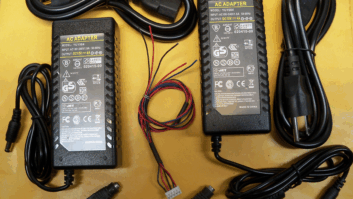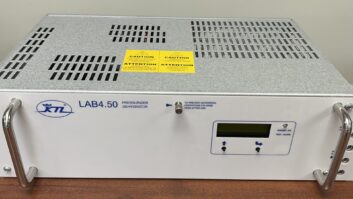Projects engineer Dan Slentz, a fellow RW contributor, points out that a lot of manufacturers have switched to RJ45 connectors for analog and AES audio in/out — and not just for AoIP applications.

Fig. 1: This inexpensive Calrad adaptor brings RJ45 connections to screw terminals.
Dan finds the pre-made stranded RJ45 cables from Monoprice to be very inexpensive — ranging from $1 to $3 — and you can get them in nearly every color and length possible at www.monoprice.com. The colors make it easy to identify the wiring.
Dan wanted to take advantage of the RJ45 for one application but had an issue when taking traditional balanced audio wiring (like the Belden 8451) into the RJ45. StudioHub makes a lot of great adaptors, though they are not inexpensive. Shown in Fig. 1, Dan found the following compact RJ45 to screw terminal strip for less than $10. The Calrad 72-171 can be ordered from Markertek (www.markertek.com) with free shipping. Just enter the Calrad part number in their search box.
***
Doug Olson is with Thermobond Buildings in Elk Point, S.D. His company recently worked with engineering consultant Clarence Beverage on a project for Radio Vision Cristiana in Ridgefield, N.J.


Fig. 2: One of four Thermobond pre-cast concrete building is being off-loaded.Fig. 3: The building set in place at the tower base.
Thermobond constructed four 10×12 foot buildings; one is shown being off-loaded in Fig. 2. The shelters were shipped to Phasetek, where they were equipped and then transported to the New Jersey site. Fig. 3 shows one of the completed shelters.
Thermobond manufactured these pre-cast concrete shelters in their Elkhart, Ind., facility. More information on the entire Thermobond line of metal shelters, light-weight shelters, cabinets and pre-cast concreted shelters can be obtained from www.thermobond.com.
***
Monadnock Broadcasting Group Chief Engineer Ira Wilner writes about Buc Fitch’s amplifier project using a good-size collection of odd parts from Radio Shack. Ira said it might be rewarding but he questions the low peak output power before clipping of the inexpensive power modules, and wonders if these modules might be a better fit for a headphone amplifier — but only if one uses DC blocking capacitors to prevent shorting out the amp with an accidental ground.
While it cost Ira a bit more money and wasn’t nearly as elegant looking, a couple of years ago he needed a battery-powered portable stereo PA. Ira’s amp will reproduce a piano with convincing fidelity and fill large spaces such as an opera house, movie theater or noisy restaurant for a flash mob performance preview of a community theater production of “Les Misérables.”
Ira raided his pile of parts and found two of his ancient miniature acoustic suspension bookshelf speakers. He bought these in the late 1970s for a car sound system.
Back then, you could not find that sort of small speaker system for automotive use. These were Grundig Hi-Fi Mini Boxes, and they had extraordinary extended bass for such tiny cabinets. In fact, nothing Ira has ever seen could match them. Passengers would always ask where the subwoofer was hidden, with disbelief that those tiny boxes were producing the sound.
As you may know, non-ported acoustic suspension baffles are very inefficient.
For Ira’s portable PA, he mounted both speakers on a 29-inch-long two-by-four scrap with L-shaped end plates. He added two 12 VDC gel cell batteries, held in place by wooden spacers and mini bungee cords. The amplifier was a 4-inch circuit board from China with a 100 Watt-times-two dual channel class D amplifier onboard. Idle current was mostly for the heat sink fan.
(See MCM part #28-20868 at www.mcmelectronics.com or Parts Express part number 320-303 at www.partsexpress.com. Either amplifier module is less than $30.)
Ira found the little Sure Electronics amplifier card from Parts Express to be extremely efficient. His fully charged 7 AH (Amp/Hour) gel cells were only down 10 percent after an evening of flash mobs around town. Uncompressed audio playback of the piano was via his trusty Zoom H4n recorder’s line out into the 2X4 wooden PA. It completely filled a 600+ seat theater with their piano accompaniment, and it sounded effortless. There was no peak distortion, reproduction was very clean. Ira estimates he was probably running peak power of around 50 Watts per channel.
Ira had fun surprising shoppers and movie audiences as they first mingled with them. His little PA would sit unobtrusively in the rear of the theatre, or on Ira’s lap, and when the piano sound file started to play, folks would look around for the piano or figured it was from the house PA up front.
Contribute to Workbench. You’ll help your fellow engineers, and qualify for SBE recertification credit. Send Workbench tips to [email protected]. Fax to (603) 472-4944.
Author John Bisset has spent 46 years in the broadcasting industry and is still learning. He handles West Coast sales for the Telos Alliance. He is SBE Certified and is a past recipient of the SBE’s Educator of the Year Award.







